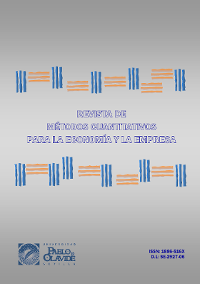Validity Examination of EFQM's Results by DEA Models
DOI:
https://doi.org/10.46661/revmetodoscuanteconempresa.2103Keywords:
European Foundation Quality Management, Data Envelopment Analysis, Fundación Europea de Gestión de la Calidad (EFQM), Análisis Envolvente de Datos (DEA)Abstract
The European Foundation Quality Management is one of the models which deal with the assessment of function of an organization using a self-assessment for measuring the concepts some of which are more and more qualitative. Consequently, complete understanding and correct usage of this model in an organization depend on the comprehensive recognition of that model and different strategies of self-assessment. The process of self-assessment on the basis of this model in an organization needs to use the experienced auditors. This leads to reduce the wrong privilege making to the criteria and to subcriteria probable way.
In this paper, first some of the weaknesses of the EFQM model are studied, then with the usage of structure of input-output governing of the model and using of Data Envelopment Analysis, a method is offered to recognize the lack of the proportion between Enablers and the results of organization which may occur due to problems and obstacles hidden in the heart of organization.
Downloads
References
Banker, R.D., A. Charnes and W.W. Cooper (1984) “Some Methods for Estimating Technical and Scale Inefficiencies in Data Envelopment Analysis”, Management Science, Vol. 30, pp. 1078-1092.
Besterfield, D.H. and C. Besterfield-Michna (1999) “Total Quality Management”, 2nd edition, Prentice Hall, New Jersey, p.135.
Charnes A., W.W. Cooper and E. Rhodes (1978) “Measuring the efficiency of decision making units”, European Journal of Operation Research, Vol. 2, pp. 429-444.
EFQM (1999) “Assessing for excellence, a practice guide for self-assessment”. EFQM, Brussels.
EFQM (2000) “Assessor Training Model”, EFQM, Brussels.
EFQM (2003a) “EFQM Levels of Excellence,” European Quality Award Information Brochure for 2003, V 6 321.
EFQM (2003b) “The EFQM Excellence Model”, European Foundation for Quality Management Brussels Representative Office, Belgium, p.2.
Golany, B. and Y. Roll (1997) “In corporating standard via DEA,” Data Envelopment Analysis (Edited by Charnes A., Cooper W., Lewin A.Y. and Seiford L.M.), Kluwer Academic Publishers, Boston.
Lacselles, D. and R. Peacock (1996) “Self-assessment for business excellence”, McGrawHill.
Downloads
Published
How to Cite
Issue
Section
License
Copyright (c) 2008 Revista de Métodos Cuantitativos para la Economía y la Empresa

This work is licensed under a Creative Commons Attribution-ShareAlike 4.0 International License.
Submission of manuscripts implies that the work described has not been published before (except in the form of an abstract or as part of thesis), that it is not under consideration for publication elsewhere and that, in case of acceptance, the authors agree to automatic transfer of the copyright to the Journal for its publication and dissemination. Authors retain the authors' right to use and share the article according to a personal or instutional use or scholarly sharing purposes; in addition, they retain patent, trademark and other intellectual property rights (including research data).
All the articles are published in the Journal under the Creative Commons license CC-BY-SA (Attribution-ShareAlike). It is allowed a commercial use of the work (always including the author attribution) and other derivative works, which must be released under the same license as the original work.
Up to Volume 21, this Journal has been licensing the articles under the Creative Commons license CC-BY-SA 3.0 ES. Starting from Volume 22, the Creative Commons license CC-BY-SA 4.0 is used.










